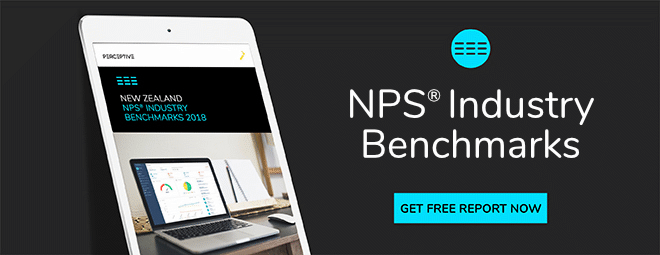You may know what your Net Promoter Score (NPS) is, but do you know if it's enough? Below you’ll learn how to tell if you have a ‘good’ NPS, along with strategies for improving for your NPS and ways to leverage NPS to grow your business.
Contents
What is a good Net Promoter Score?
What is the impact of location on NPS?
What is the impact of industry on NPS?
How can I improve my NPS?
How to use NPS to be more competitive
Why NPS benchmarking is important
How NPS benchmarking keeps your business competitive
What’s the NPS for high growth rate companies?

Download free NPS benchmarking reports by industry for New Zealand and Australia
What is a good NPS?
Any NPS score above 0 is "good". It means that your audience is more loyal than not. Anything above 20 is considered "favourable". Bain & Co, the source of the NPS system, suggests that above 50 is excellent, and above 80 is world class.
However, these are only general guidelines. A ‘good NPS’ will depend on the industry and country a business is in.
What is the impact of location on NPS?
In Europe, for example, customers tend to be more conservative with their ratings. A high score, a 9 or a 10, is rare. Japan has a similar reaction, as it is considered poor etiquette to provide a company with a perfect score. In the US, on the other hand, it is far more common to see higher scores, with low scores being just as rare as high ones are in conservative countries.
In other countries, scores are more extreme, with dissatisfied customers liberally using the lower end of the scale, and even mildly impressed clients honouring a business with a full 10/10.
For example, one of Perceptive’s global SaaS clients has an enormous difference in its average NPS from country to country. In Singapore, the company scores 20 points lower than their global average. In the United States, it scores 10 points higher.
This is a single company offering similar products and services from country to country to similar people. But the average NPS varies wildly. This might be for legitimate reasons, such as poor customer support in some areas, but it will still be heavily affected by the likelihood (or lack thereof) of people rating the same across countries.
Knowing what a “good NPS” is the world over quickly becomes difficult. However, a rule of thumb for those looking for guidance:
As a general rule in New Zealand and Australia, you should aim for an average NPS of 30.
Related content: How do you calculate a Net Promoter Score?
What is the impact of industry on NPS?
Your industry may naturally lend itself to lower NPS as a whole.
Property management and debt collection, for example, tend to score in the negatives. Check your score against NPS benchmarks for your specific industry to ensure this isn't the case.
If you do find that your industry scores poorly across the board, you have been presented with an opportunity. If you can impress even a small number of clients/customers, you can outpace the competition in customer experience.
If you're in a niche industry and NPS data isn't readily available, benchmark yourself against your previous performance instead. If you are improving by about 10 per cent a quarter, you can assume you are heading in the right direction. This is true even if your recent score is still negative—it just has to be less negative.
We also provide specific advice on improving NPS in the hotel, insurance and telecommunications industries.
Related content: The top 3 Net Promoter Score industries in Australia and New Zealand
How can I improve my NPS?
If you find that you have a low net promoter score, don't panic. There are a number of reasons why this may be the case.
Read more: 3 ways to increase your survey response rate
1) Technical issues
NPS survey design and deployment is complex with a number of moving parts. If you are handling this yourself rather than going through a reputable market research agency, ensure that all of those moving parts are operating smoothly.
Keep an eye out for issues such as the following:
- Low response rates.
- Survey 'bombing' or the act of sending out multiple surveys in a short amount of time.
- Leading questions.
- The use of financial rewards for high scores.
- Inappropriate or badly weighted survey methodology e.g. phone call vs online.
Note this also applies if you have a strangely high score compared to previous performance. Accuracy is key, not vanity.
If you do uncover these problems, we recommend going through a specialist customer insights service provider to ensure you are getting accurate data.
Related content: How to use NPS to inform your customer journey map
2) Experience issues
If you’re sure that your NPS surveys are going off without issue (which should be the case if you are using a specialist NPS advisor), it’s likely that genuine customer experience-related issues are to blame for a poor score.
Sammie Parkinson, CX Team Leader at Perceptive, has some insight into how business can improve their chances of a better NPS:
“In our experience, it is often the most simple things letting a business down. Pick up the phone faster, reduce wait times, and, in general, just communicate better,” she explains.
“Don’t make your customers come to you. Go to them—this will massively improve your customer satisfaction and, invariably, your NPS too.”
Generally speaking, improving your NPS centres on one thing: providing a good experience for your customers, keeping them at the centre of your business, and should you fail at some point, make sure you react immediately to rectify the situation.
Related content: How to increase your Net Promoter Score percentage in 5 easy steps
How to use NPS to be more competitive
NPS allows a company to understand their place in their industry as a whole, rather than just its own reputation in a vacuum—enabling it to see how they can leverage their own unique position to outclass the competition.
“You can identify the needs and, often, wants of your customers with a single question in the NPS surveys,” Sammie explains.
“Once you have identified the one major improvement you can make as a business right now, you instantly gain insight into what is going to provide real ROI in your business.”
A good NPS score is more than just a number. It’s a comparison to your peers, it’s an indicator of your current success, and it’s a way to gain direct, actionable insight into where your business needs to go next.
Don’t be distracted by the pure metrics. The NPS system can provide so much more.
Related content: Grow your business with NPS [free eBook]
Why NPS benchmarking is important
Knowing your Net Promoter Score is highly valuable, as you'll know what is needed to improve your services where it’s needed the most. Knowing your NPS benchmark score, that is, what the average NPS is for your industry, will mean that you can understand how you rate compared with others in your industry. You'll instantly understand whether your business is competitive enough compared to your competitors or if you need to improve.
As a business leader and strategic decision maker, you’ll then get a further insight into the major threats and opportunities in the marketplace, which will help set priorities for your business with confidence.
Related content: Grow your business with NPS [free eBook]
How to keep your business competitive with NPS benchmarking
Your Net Promoter Score (NPS) is much more than just a customer loyalty metric. It’s a tool that gives your business the ability to know how you rank against the competition—and more importantly, how to get to the top of the leaderboards.
Get beyond the average
Your NPS score tells you how your customers view your business, products and/or services, and why. This identifies particular pain points, as well as opportunities that your company isn’t taking advantage of yet.
For some, that might be enough—but we know you don’t just want to do ‘enough’. You want to become a leader in your industry. A good NPS score isn’t just about how well your business is doing in general, but also about how well you are doing in comparison to your peers.
That’s where the Perceptive Group’s competitive NPS benchmarking comes in.
How does NPS benchmarking work?
Because “What is a good NPS score?” is one of the most common questions we get asked, we've collated a wealth of information about the overall NPS scores for a multitude of industries.
With this data, we can provide you with an average benchmark for your industry. Every industry average is different, each sector creating new Promoters and Detractors at different rates. You wouldn’t compare an electronics retailer to an agribusiness in terms of yearly turnover—so why do it for customer perception?
If your company is beyond your industry average, you now have data-driven confirmation that your current strategies are working. You can prioritise similar projects and continue to grow with confidence.
If you find your business is struggling to hit the average, however, then the benchmark tells you it is time to take another look at your strategies and customer pain points.
NPS benchmarking gives you the opportunity to build upon your strengths and work around your weaknesses to deliver better outcomes for your customers. Ultimately, that gives your business the direction it needs to remain competitive.
What’s the NPS for high growth rate companies?
Bain & Co research has shown that companies with the most efficient growth rate have Net Promoter Scores of between 50 and 80. This will vary from industry to industry, but this is a good goal to aim for on a wide scale.
However, most companies are falling well short of this range, the average only sitting on an NPS between 5 and 10. In other words, their Promoters barely outnumber their Detractors. These businesses are delighting almost as often as they are disappointing.
Sometimes entire industries have negative Net Promoter Scores. Considering how important the customer/client experience is for commercial success, this is a clear indicator of why so many businesses struggle to deliver profitable, sustainable growth.
Even if they aggressively chase new business, they are losing all they gain at the other end of the scale. Many don’t even know that their NPS scores are in the negative, or are lower than their industry average. Once again, benchmarking could have provided the information needed to adjust their failing direction.
Sammie Parkinson, CX Team Leader at Perceptive, explains further:
"We find that when businesses apply the learnings from an NPS programme – that is what truly makes the difference in the score,” she says. “We find that when businesses apply the learnings from an NPS programme – that is what truly makes the difference in the score. Not just a high NPS score, but one that is defendable and is creditable too.”
NPS is far more than just customer loyalty metrics. It provides direction, strategy and an indicator of when things are going right—and wrong. It’s a data-driven solution to the most common issues for Australian and New Zealand businesses.
Isn’t it about time you measured your enterprise against the competition?
How does your NPS measure up against the rest of your industry? Download our free benchmark reports for New Zealand and Australia to find out!
